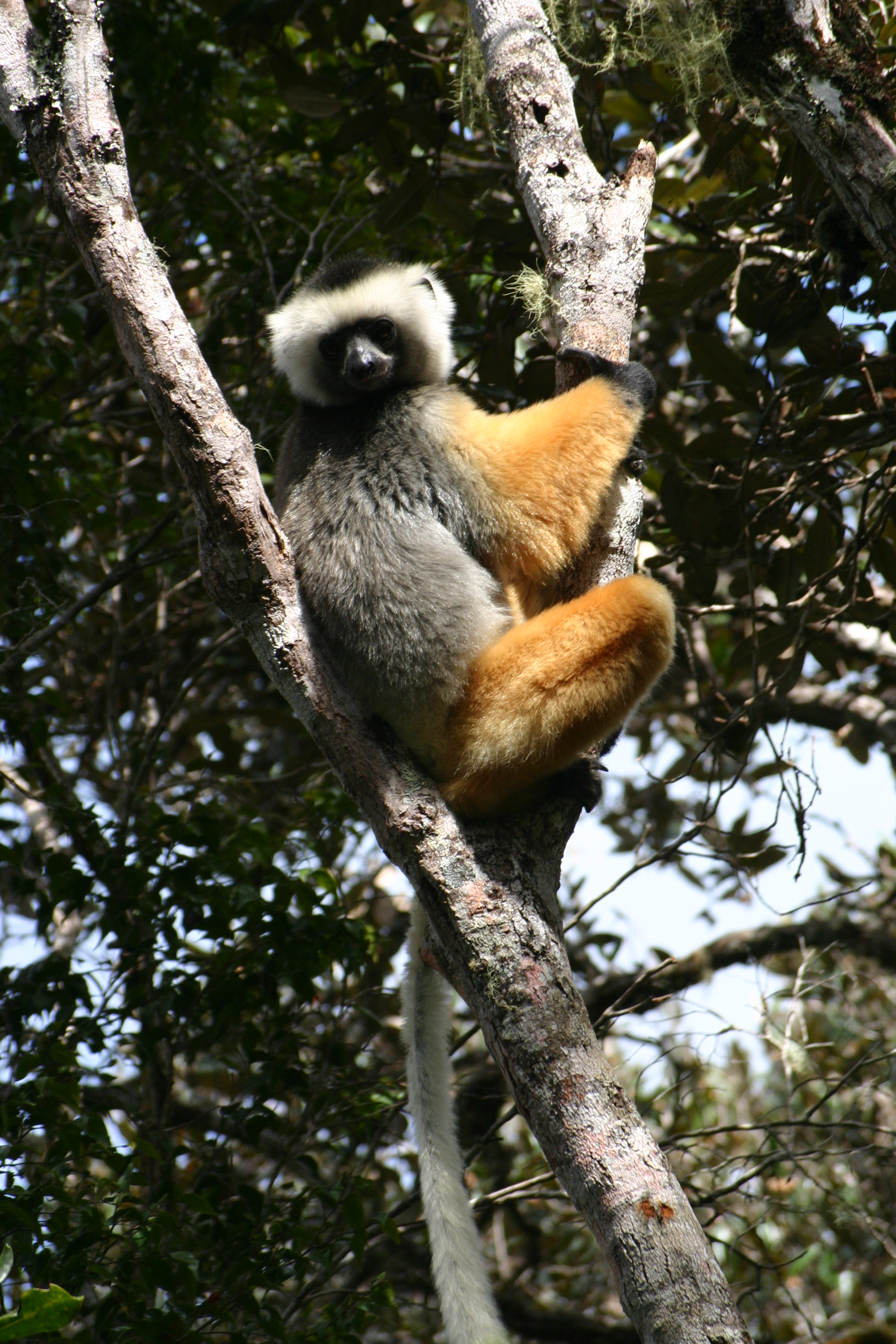- Sifaka
Taxobox
name = SifakasMSW3 Groves|pages=120-121]

.jpg)
image_width = 220px
image_caption =Diademed Sifaka ("Propithecus diadema")
regnum =Animal ia
phylum =Chordata
classis =Mammal ia
ordo =Primate s
familia =Indriidae
genus = "Propithecus"
genus_authority = Bennett, 1832
type_species = "Propithecus diadema"
type_species_authority = Bennett, 1832
subdivision_ranks =Species
subdivision = * "Propithecus diadema"
* "Propithecus candidus"
* "Propithecus edwardsi"
* "Propithecus perrieri"
* "Propithecus tattersalli"
* "Propithecus verreauxi"
* "Propithecus coquereli"
* "Propithecus deckenii"Sifakas are a
genus ("Propithecus") from theprimate familyIndriidae . Like alllemur s, they are found only on the island ofMadagascar .Sifakas are medium sized indrids, reaching a length of 45 to 55 cm (about 18-22 in) and a weight of 4 to 6 kg (about 9-13 lbs). Their tail is just as long as their body, which differentiates them from the
Indri . Their fur is long and silky, with coloration varying by species from yellowish-white to black brown. The round, hairless face is always black.Sifakas are diurnal and
arboreal . They are skillful climbers and powerful jumpers, able to make leaps of up to 10 m from one tree to the next. On the ground they move like all indrids with hopping movements of the hind legs, holding their forelimbs up for balance. When not searching for food they spend a good part of the day sun bathing, stretched on the branches. Sifakas live in larger groups than the other indrids (up to 13 animals). They have a firm territory, which they mark with smell glands. Edges of different sifaka territories can overlap. Even though they defend their territory from invasion by others of their species, they may peacefully co-exist with other lemur species such asRed-bellied Lemur and theCommon Brown Lemur .Sifakas are
herbivore s, eating leaves, flowers and fruits.A four to five month gestation period ends with the birth of a single offspring in July. The young holds fast to the mother's belly when small, but then later is carried on her back. Young are weaned after about six months and reach full maturity at the age of two to three years. The life expectancy of the sifakas is up to 18 years.
Classification
* Family
Indriidae : woolly lemurs and allies
** Genus "Indri "
** Genus "Avahi"
** Genus "Propithecus" [cite journal | author = Mireya I. Mayor, Julie A. Sommer, Marlys L. Houck, John R. Zaonarivelo, Patricia C. Wright, Colleen Ingram, Stacia R. Engel and Edward E. Louis Jr. | title = Specific Status of "Propithecus" spp. | journal = International Journal of Primatology | volume = 25 | issue = 4 | month = August | year = 2004 | pages = 875–900 | doi = 10.1023/B:IJOP.0000029127.31190.e9]
*** "P. diadema" group
****Diademed Sifaka , "Propithecus diadema"
****Silky Sifaka , "Propithecus candidus"
****Milne-Edwards' Sifaka , "Propithecus edwardsi"
****Perrier's Sifaka , "Propithecus perrieri"
****Golden-crowned Sifaka , "Propithecus tattersalli"
*** "P. verreauxi" group
****Verreaux's Sifaka , "Propithecus verreauxi"
****Coquerel's Sifaka , "Propithecus coquereli"
****Van der Decken's Sifaka , "Propithecus deckenii"
****Crowned Sifaka , "Propithecus coronatus"References
External links
* [http://pin.primate.wisc.edu/factsheets/links/propithecus Primate Info Net "Propithecus" Factsheets]
* [http://www.nyas.org/snc/podcastdetail.asp?id=1845 New York Academy of Sciences Podcast]
* [http://video.nationalgeographic.com/video/player/animals/mammals-animals/monkeys-and-lemurs/lemur_sifaka_search.html?fs=animals-panther.nationalgeographic.com National Geographic video]
Wikimedia Foundation. 2010.
